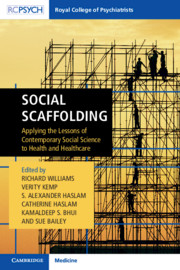Book contents
- Social Scaffolding
- Social Scaffolding
- Copyright page
- Contents
- Contributors
- Foreword
- Note
- Section 1 Schooling
- Section 2 Scoping
- Section 3 Sourcing
- Chapter 15 Crowds and Cooperation
- Chapter 16 Emergencies, Disasters and Risk Reduction: A Microcosm of Social Relationships in Communities
- Chapter 17 Shared Social Identity in Emergencies, Disasters and Conflicts
- Chapter 18 Complex Trauma and Complex Responses to Trauma in the Asylum Context
- Chapter 19 The Mental Health of Veterans: Ticking Time Bomb or Business as Usual?
- Chapter 20 Violent Radicalisation: Relational Roots and Preventive Implications
- Chapter 21 Ways Out of Intractable Conflict
- Chapter 22 Agency as a Source of Recovery and Creativity
- Section 4 Scaffolding
- Section 5 Sustaining
- Index
- References
Chapter 15 - Crowds and Cooperation
from Section 3 - Sourcing
Published online by Cambridge University Press: 14 June 2019
- Social Scaffolding
- Social Scaffolding
- Copyright page
- Contents
- Contributors
- Foreword
- Note
- Section 1 Schooling
- Section 2 Scoping
- Section 3 Sourcing
- Chapter 15 Crowds and Cooperation
- Chapter 16 Emergencies, Disasters and Risk Reduction: A Microcosm of Social Relationships in Communities
- Chapter 17 Shared Social Identity in Emergencies, Disasters and Conflicts
- Chapter 18 Complex Trauma and Complex Responses to Trauma in the Asylum Context
- Chapter 19 The Mental Health of Veterans: Ticking Time Bomb or Business as Usual?
- Chapter 20 Violent Radicalisation: Relational Roots and Preventive Implications
- Chapter 21 Ways Out of Intractable Conflict
- Chapter 22 Agency as a Source of Recovery and Creativity
- Section 4 Scaffolding
- Section 5 Sustaining
- Index
- References
Summary
This chapter does two things. First, it shows how social identity principles can explain the basic psychological and behavioural effects of crowd membership. Second, it describes some recent research and applied work that shows how these basic effects operate to contribute to harmonious outcomes in potentially dangerous crowd events.
We begin by explaining some of the fundamental psychology of crowd membership in the next section.
- Type
- Chapter
- Information
- Social ScaffoldingApplying the Lessons of Contemporary Social Science to Health and Healthcare, pp. 129 - 136Publisher: Cambridge University PressPrint publication year: 2019

